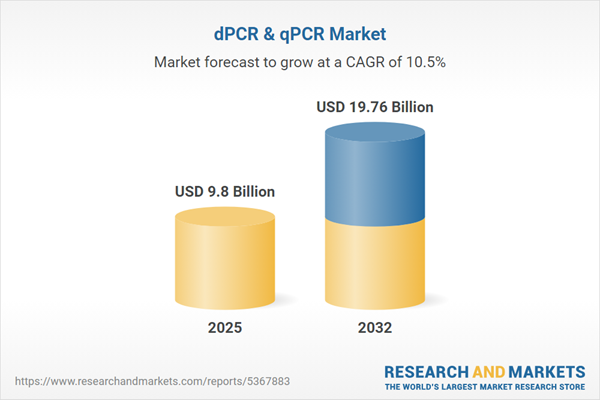Speak directly to the analyst to clarify any post sales queries you may have.
The dPCR & qPCR Market is a dynamic, high-growth sector, driven by rapid technology adoption in life sciences and diagnostics. Senior leaders face critical decisions as innovation, regulation, and supply chain complexity redefine global strategies.
Market Snapshot: dPCR & qPCR Market Growth and Trends
The dPCR & qPCR Market grew from USD 8.88 billion in 2024 to USD 9.80 billion in 2025. It is expected to continue growing at a CAGR of 10.51%, reaching USD 19.76 billion by 2032. This market is shaped by ongoing innovation in digital PCR and real-time quantitative PCR platforms, with significant attention to regulatory changes and global supply chain adaptations. Key factors include automation, multiplexing, and the integration of next-generation analytics, positioning the sector for continued expansion into diverse industries.
Scope & Segmentation
- Product Type: Consumables (kits, reagents, PCR master mixes, probe and primer sets, microfluidic chips, plates, tubes), instruments (digital PCR instruments, real-time PCR instruments), software and services (data analysis software, maintenance, support services).
- Technology Type: dPCR and qPCR platforms supporting absolute quantification and dynamic monitoring.
- Application: Academic research, clinical diagnostics (infectious disease testing, oncology testing), food testing and agriculture (GMO analysis, pathogen detection), pharmaceutical research (drug discovery, pharmacogenomics).
- End-User: Academic and research institutes, forensic laboratories, hospitals and diagnostic labs, pharmaceutical and biotechnology companies.
- Geographic Coverage: Americas (United States, Canada, Mexico, Brazil, Argentina, Chile, Colombia, Peru), Europe, Middle East & Africa (including United Kingdom, Germany, France, Russia, Italy, Spain, Netherlands, Sweden, Poland, Switzerland, United Arab Emirates, Saudi Arabia, Qatar, Turkey, Israel, South Africa, Nigeria, Egypt, Kenya), Asia-Pacific (China, India, Japan, Australia, South Korea, Indonesia, Thailand, Malaysia, Singapore, Taiwan).
- Company Coverage: Thermo Fisher Scientific Inc., Danaher Corporation, F. Hoffmann-La Roche Ltd., Bio-Rad Laboratories, Inc., QIAGEN N.V., Agilent Technologies, Inc., PerkinElmer, Inc., Promega Corporation, Takara Bio Inc., Merck KGaA.
Key Takeaways for Senior Decision-Makers
- Digital PCR and qPCR innovations have moved from specialty applications to essential roles in diagnostics and molecular research, addressing low-abundance target detection with high sensitivity.
- Segment growth is diversified; consumables maintain recurring demand and technological upgrades in instruments offer new revenue streams, while supporting software accelerates data-driven workflows.
- Integration with sequencing and bioinformatics tools drives complex genomic studies, expanding research and clinical impact.
- Emerging platforms offer flexibility with hybrid modes, enabling laboratories to customize assays for varied throughput and target specifications.
- Regional development is shaped by distinctive regulatory environments, infrastructure investments, and local manufacturing partnerships; Asia-Pacific is an innovation hotspot, while Americas lead in companion diagnostics adoption.
- Strategic alliances between manufacturers, software specialists, and service providers are consolidating expertise, delivering full-spectrum solutions, and strengthening resilience against market shifts.
Tariff Impact on Supply Chain and Pricing
Recent United States tariff schedules have altered supply chain strategies for digital and quantitative PCR companies. Manufacturers are diversifying sourcing, prioritizing localized production, and working with suppliers in non-tariff regions to contain costs. Laboratory purchasers face recalibrated procurement policies, balancing increased upfront costs with longer-term supply resilience. Market competitiveness is preserved through bundled reagent and service offerings that reduce procurement impact. Regulatory and industry collaboration is intensifying around tariff relief and duty reclassification for life science tools.
Methodology & Data Sources
This report applies rigorous primary and secondary research, including stakeholder interviews, journal and patent analysis, and data triangulation for market accuracy. Quantitative modeling assessed tariff implications and cost drivers, while qualitative techniques mapped technology adoption and regional trends. Strict ethical standards were maintained throughout the data collection process.
Why This Report Matters
- Enables agile, data-driven business decisions with comprehensive segmentation and emerging trend analysis.
- Supports risk mitigation by clarifying tariff impacts and supply chain resilience strategies.
- Highlights actionable growth opportunities across product, technology, and regional segments for short- and long-term planning.
Conclusion
Senior leaders navigating the dPCR & qPCR Market will benefit from actionable insights into tech innovation, supply strategies, and evolving segment dynamics. This report equips decision-makers to align investments with shifting global opportunities and competitive benchmarks.
Additional Product Information:
- Purchase of this report includes 1 year online access with quarterly updates.
- This report can be updated on request. Please contact our Customer Experience team using the Ask a Question widget on our website.
Table of Contents
3. Executive Summary
4. Market Overview
7. Cumulative Impact of Artificial Intelligence 2025
Companies Mentioned
The companies profiled in this dPCR & qPCR market report include:- Thermo Fisher Scientific Inc.
- Danaher Corporation
- F. Hoffmann-La Roche Ltd.
- Bio-Rad Laboratories, Inc.
- QIAGEN N.V.
- Agilent Technologies, Inc.
- PerkinElmer, Inc.
- Promega Corporation
- Takara Bio Inc.
- Merck KGaA
Table Information
| Report Attribute | Details |
|---|---|
| No. of Pages | 186 |
| Published | October 2025 |
| Forecast Period | 2025 - 2032 |
| Estimated Market Value ( USD | $ 9.8 Billion |
| Forecasted Market Value ( USD | $ 19.76 Billion |
| Compound Annual Growth Rate | 10.5% |
| Regions Covered | Global |
| No. of Companies Mentioned | 11 |









